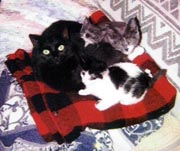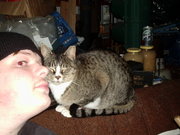

Custom Search
|
 Rescued feral kittens - Most feral kittens have little chance of surving
more than a few months and are vulnerable to starvation, predators, disease and
even flea-induced anemia. Here, kittens from two feral litters are fostered by a
domestic mother.
Rescued feral kittens - Most feral kittens have little chance of surving
more than a few months and are vulnerable to starvation, predators, disease and
even flea-induced anemia. Here, kittens from two feral litters are fostered by a
domestic mother.A feral cat is a cat which has been separated from domestication, whether through abandonment, loss, or running away, and become wild. The term also refers to descendants of such cats, but not to Wild Cats, whose ancestors were never domesticated. It's a common myth that feral cats usually cannot be re-socialized, even though it is difficult and not all cats will take to it. Feral kittens, however, can be much easier socialized to live with humans if they are taken from a feral colony before they are about twelve weeks old.
Feral cats may live alone, but are usually found in large groups called feral colonies with communal nurseries, depending on resource availability. Many abandoned pet cats join these colonies out of desperation; these cats can usually be readopted into a new home. The average life span of a feral cat that survives beyond kittenhood is usually less than two years while a domestic housecat lives an average of sixteen years or more.
 TNR: Some adult feral cats can be socialized, depending on the degree of human
interaction throughout their lives; feral kittens have a good chance of
socialization and adoption up to about four months of age. Ferals like this one
have one ear tipped prior to return to the feral colony, which identifies this
feline as altered. This feral cat, however, was lucky enough to be brought
together with a patient owner and resocialized.
TNR: Some adult feral cats can be socialized, depending on the degree of human
interaction throughout their lives; feral kittens have a good chance of
socialization and adoption up to about four months of age. Ferals like this one
have one ear tipped prior to return to the feral colony, which identifies this
feline as altered. This feral cat, however, was lucky enough to be brought
together with a patient owner and resocialized.
Cityscapes and North America are not native environments for the cat; the domestic cat comes from temperate or hot, often dry, climates and was distributed throughout the world by humans. Although cats are somewhat adaptable, feral felines are unable to survive in extreme cold and heat, and with a need for a diet of 90% protein, few cats find adequate nutrition on their own. In addition, they have no defense against or understanding of such predators as dogs, coyotes and even automobiles. The current population of twenty to forty million feral felines in the United States is due, initially, to human interference by environmental introduction and later, by simple human irresponsibility and neglect.
In the United States Trap-Neuter-Return or TNR programs are facilitated by many volunteers and organizations. In addition to sterilization, inoculation against rabies and the feline leukemia virus as well as the application of long-lasting flea treatments before release are common. Frequently, attending veterinarians nip the tip off one ear to mark the feral as spayed or neutered and inoculated, as these cats will more than likely find themselves trapped again. Volunteers often continue to feed and give care to these cats throughout their lives. Many would like to do more, but most fully feral cats are unadoptable unless trapped and socialized before four months of age.
The TNR program is considered a humane, efficient way to deal with the problem of feral cats for several reasons. The wholesale removal of feral colonies by euthanasia is rarely effective, since new individuals move into the areas left by the removed animals almost immediately, and the blanket euthanasia of stray and feral cats has proven ineffective in controlling stray and feral overpopulation. TNR posits that, by providing basic care for a stable, neutered colony of feral cats, most of the problems associated with their presence can be eliminated or greatly reduced. As the existing cats are better fed and cared for, their lives are extended, and neutering stops the influx of kittens to replace adults dying from disease or starvation. This stable colony is less likely to compete for food or predate on local wildlife if it is fed regularly, and fighting with domestic pet cats, roaming, and other nuisance behaviours are greatly reduced by neutering.
By providing this basic support, caretakers insure that the resident colony will stabilize and prevent unknown new cats from moving into the neighborhood. As individuals in the colony die, new ferals move in to take their place, and can be trapped, neutered and vaccinated as they appear. Over time, these stabilized feral colonies can become sources of enjoyment and pride to neighborhoods rather than nuisances. Given the choice between a colony of rapidly reproducing, starving, and diseased animals and a colony of neutered animals given basic healthcare, the desirable choice is obvious to all.
Recognizing the ineffectiveness of blanket euthanasia as a means of controlling stray and feral cat population, more and more animal shelters throughout the United States are becoming no kill shelters , and are gradually implementing more humane and effective animal population control methods. Some states such as California and many countries around the world have had tremendous success with humane methods to control feral cat populations. A proposal in the state of Wisconsin to legalize the hunting of feral cats in an attempt to reduce their population was recently (April 2005) blocked by the state's lawmakers. South Dakota and Minnesota still allow wild cats to be shot.
There is no doubt feral cats will hunt other small animals. Some people see this as a problem in itself, due to the suffering and death inflicted on the prey. Others instead support the killing of mice, rats and other rodents, whom they perceive as pests. Many object to the killing of songbirds and other birds on conservation grounds. Some estimate the bird loss at over two hundred million a year. These figures may be questionable, however, with some of the damage due to the resurgence of other small predators such as the gray fox (urocyon cinereoargenteus), fisher or pekan (martes pennanti), coyote (canis latrans), and puma (puma concolor). The loss of species due to overbuilding of native habitat by humans far outstrips that lost to feral cat predation.
October 16 is National Feral Cat Day in the United States.
Feral cats have been present in Australia since European settlement, and may have arrived with Dutch shipwrecks in the 17th century. Intentional releases were made in the late 19th century in the hope that cats would control mice, rabbits and rats.
The feral cat has been an ecological disaster in Australia, inhabiting most ecosystems except dense rainforest, and being implicated in the extinction of several marsupial and placental mammal species but there is no proof to support this view. (Cats are not believed to have been a factor in the extinction of the only mainland bird species to be lost since European settlement, the Paradise Parrot; their role in the loss of rare species on Australasian islands, however, has been significant.) Convincing evidence that cats exert a significant effect on native wildlife throughout the mainland is lacking - Environment Australia
Folklore has it that some feral cats in Australia have grown so large as to cause inexperienced observors to claim sightings of other species, and subsequent news stories of mysterious animals being sighted. Typical locations for such sightings are south-west Western Australia, and the Nullabor.
Control programs are difficult to devise due to the nocturnal and solitary nature of feral cats, broad distribution in the landscape and continuous additions to the population from abandoned domestic cats. Due to the danger posed to humans handling the animal, captured feral cats are almost always killed. Although trap neuter and return programs such as those in the United States are not prevalent in Australia, they are now being introduced in some urban and suburban areas such as Adelaide. More recently, such programs have been introduced in Sydney by the World League for Protection of Animals .
Rome, Italy is perhaps the place with most feral cats, the total number being estimated between 250,000 and 350,000, organized in about 2,000 colonies, some of them living in famous ancient places such as the Colosseum.
Feral cats introduced to islands with ecologically naive fauna (that is, species that have not evolved or have lost predator responses for dealing with cats) have had a devastating impact on these islands' biodiversity. They have been implicated in the extinction of several species and local extinctions, such as the huitas from the Caribbean and the Guadalupe Storm-petrel from Pacific Mexico. Moors and Atkinson wrote, in 1984, No other alien predator has had such a universally damaging effect. Given the damage they do, many conservationists working in the field of island restoration (literally restoring damaged islands through removal of introduced species and replanting and reintroducing native species) have worked to remove feral cats. As of 2004, 48 islands have had their feral cat populations removed, including New Zealand's network of offshore island bird reserves (Nogales et al, 2004). Larger projects are also being planned, including their removal from Ascension Island.
Feral cats, along with rabbits and some sea birds, are the entire animal population of the remote Kerguelen Islands in the southern Indian Ocean.
Feral cats colonies often arise from stray or abandoned unneutered cats. The cats breed rapidly and have multiple-kit litters although relatively few kittens survive to breeding age. Often the owners do not have the capacity or desire to care for a large number of cats.
The conditions lived in by feral cats vary immensely. Some have short, dangerous, unhealthy, desperate lives, in deplorable conditions. Others are welcomed as working cats around factories and farms and while their lives not luxurious, some live well into their teenage years. <!-Cat Action Trust has encountered ferals up to 19 years old, record age for feral is 26 - Cats Protection League --> Because of the perceived dangers to humans, other species, and the cats themselves, and out of compassion toward the animals, many people, including celebrities such as Bob Barker, campaign to encourage people to spay and neuter their pets and support the humane control of feral cats.
A growing number of animal societies realise that feral cats are wild animals and should not be judged by pet animal standards. Where the cats perform a useful task or are not a threat to the local ecology, the approach is to trap, neuter and return them to their own habitat, while removing any ill, injured or tameable individuals.
Cats, made by MultiMedia | Free content and software
This guide is licensed under the GNU Free Documentation License. It uses material from the Wikipedia.